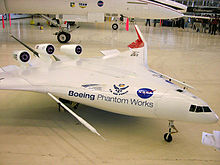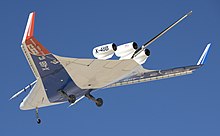Boeing X-48
The Boeing X-48 is an American experimental unmanned aerial vehicle (UAV) built to investigate the characteristics of blended wing body (BWB) aircraft.
[4] The McDonnell Douglas engineers believed their design had several advantages, but their concept, code named "Project Redwood", found little favor at Boeing after their 1997 merger.
[5][6] The most difficult problem they solved was that of ensuring passengers a safe and fast escape in case of an accident, since emergency door locations were completely different from those in a conventional aircraft.
[7] The blended wing body (BWB) concept offers advantages in structural, aerodynamic and operating efficiencies over today's more conventional fuselage-and-wing designs.
[citation needed][vague] Boeing Phantom Works developed the blended wing body (BWB) aircraft concept in cooperation with the NASA Langley Research Center.
In an initial effort to study the flight characteristics of the BWB design, a remote-controlled propeller-driven blended wing body model with a 17 ft (5.2 m) wingspan was flown in 1997.
[18] In November 2006, ground testing began at Dryden, to validate the aircraft's systems integrity, telemetry and communications links, flight-control software and taxi and takeoff characteristics.
[19] The X-48C has its vertical stabilizers moved inboard on either side of the engines, and its fuselage extended aft, both to reduce the aircraft's noise profile; it was to be powered by two JetCat turbines, each producing 80 pounds-force (360 N) of thrust.
[17][18][24] The remotely piloted aircraft was successfully stalled for the first time on September 4, 2008, with fixed leading edge slats, a forward center of gravity, and 23-degree angle of attack (2° beyond the maximum coefficient of lift).




